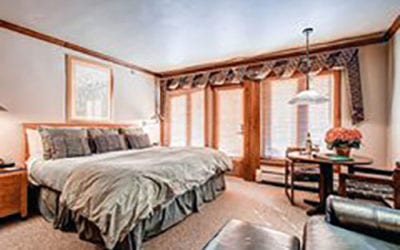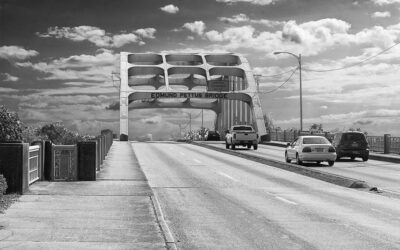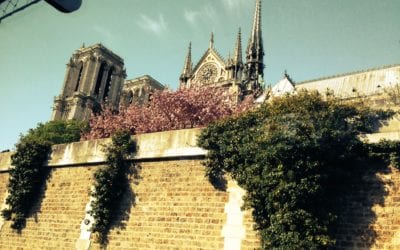
En route to Banff, The Rocky Mountaineer runs for several miles along the banks of Suswap Lake in British Columbia
A rail excursion through the mountains of Western Canada aboard the Rocky Mountaineer has long been on my list of to-do train rides. And this morning, here I am in Vancouver, watching a quarter-mile-long train in stunning blue and gold livery ease to a gentle stop at the platform right in front of me.
It’s an impressive train: twin locomotives, five service and crew cars, and eleven cars for a complement of more than 500 passengers. The last six cars are bi-level beauties, with glass domes for panoramic views from the seating area on the upper level, and a formal dining area plus kitchen below. Furthermore, there are gated vestibules between these cars, permitting open air viewing of the mountains and rivers awaiting us up ahead.
For me, this will be a two-day journey, stopping late this afternoon in Kamloops, where passengers will spend the night in one of the town’s hotels, then continuing on tomorrow to the mountain resort town of Banff.
I’ve splurged on the railroad’s Gold Leaf service for this trip and am ushered into one of the bi-level cars, getting just a peek at a formal dining area as I climb the circular stairway to my seat on the upper level.
Not five minutes later, we’re under way, rolling silently through Vancouver’s extensive Thornton Rail Yard and out onto the main line. A gaggle of a dozen Canada geese waddling along an adjacent track ignores us as we pass, while off to the right, construction workers on the roof of a building stare and then wave.
After rollicking along for nearly 15 minutes, we slow and slide off onto a siding. Minutes later, VIA Rail’s train # 1, the Canadian, rolls by, about to complete its four-night trans-continental journey from Toronto to Vancouver. (One of the world’s great rail journeys, by the way, and one I’ve already checked off my list.)
An hour later, I’ve been seated in the lower level dining area and am just starting in on a perfectly prepared Eggs Benedict. As on most trains, the Rocky Mountaineer features community dining and my companions for breakfast this morning are a mother and her 20-something son from Buffalo, New York. She’s a banker just beginning her early retirement; he is a pastry chef.
We’re now running through a broad, lush valley with snow-topped mountains in the distance. Just off to our left is the broad Fraser River. Our car’s host, Henry de Salengre, who periodically provides us with commentary on passing points of interest, says the Fraser is noteworthy because it drains more than 84,000 square miles of Western Canada and, since there are no dams along its 850-mile course, it’s a major salmon run. From here on, he says, we should be on the lookout for wildlife.
By mid-afternoon, we’re well into the mountains when someone seated toward the front of the car calls out, “Sheep! Sheep!” Sure enough, a herd of about 20 big horn sheep are scrambling up a steep rocky slope on the right side of the train. Our own scramble follows as passengers leap across the aisle, clutching cameras. Minutes later, just as I spot a man trudging across a field toting a feed bucket, someone calls out “Farmer! Farmer!” After the laughter subsides, Henry announces that since it’s five o’clock somewhere, he will be coming down the aisle taking orders for complimentary drinks.
The Fraser River is still with us, but now it’s narrowed to a foaming torrent. The train slows as we approach Hell’s Gate, where the river’s full volume of water thunders through a pinch-point in the mountain pass just over 100 feet wide. A dozen of us scramble down the stairway to be on the open vestibule with our cameras as we pass.
A fleet of buses is waiting when we arrive in Kamloops, ready to transport us all to one of several pre-booked hotels. Our luggage has already been brought here by truck and is already in our hotel room. On this trip, no detail has been overlooked.
The same bus is waiting for us the next morning. Dave, the 50-ish driver, breezily announces that freight traffic on the Canadian National Railway has delayed the arrival of our train at the Kamloops station. Since it’s not quite 6:30 a.m., this news is not greeted with a great deal of enthusiasm. Not to worry, says Dave, because he will take us on an “orientation tour” of Kamloops. Two minutes later, the bus slows at the first point of interest. It’s the city’s wastewater treatment plant.
To everyone’s surprise, our bus tour turns out to be entertaining and, despite the early hour, everyone is cheerful when we arrive at the station where our train – and, of course, another gourmet breakfast – is waiting. Joining me at the table is an attractive Brazilian couple, both ethnic Japanese, but now living in Washington, where he is head of a trade delegation.
Later in the morning, after running through a heavily forested area for some time, we abruptly emerge several hundred feet above the south shore of Lake Shuswap. It’s a large body of water – the 4th largest lake in British Columbia, in fact – and is also known for being home to a great many houseboats. Indeed, from our vantage point, a half dozen of the floating boxes can be seen plowing sedately to and fro across the lake’s glassy surface.
An hour later, we’ve left the lake behind and are crossing valleys dotted with tidy farmhouses. Broad fields are studded with bales of hay waiting to be gathered and stored for the coming winter. Horses graze in neat pastures, many bisected by running streams that spread out before burbling over beaver dams and continuing on their way. But overlooking this pastoral scene are some of the more impressive mountains we’ve seen so far … majestic gray-black peaks topped with wedges of deep snow still melting into streams that tumble down impossibly sheer rock walls, then disappear into forests of silver birch, hemlock, and Douglas fir.
After another gourmet lunch, the Rocky Mountaineer runs along the Kicking Horse River. It’s not as wide as the Fraser, but it dashes along madly, churning and foaming down through the steep narrow gorge. Several of us snatch up our cameras and dash down to the open vestibule, just in time to see two inflatable rafts come swirling past. A young man manages to give us a quick half-wave before jamming his paddle back into the maelstrom and stroking furiously as his raft careens around a huge boulder.
After a half-hour or so, damp from the chilly mist, I give up my spot at the vestibule railing and return to the upper level of the rail car just in time to be greeted by Henry, once again coming down the aisle taking beverage orders.
Banff is just two hours away now, but a final treat awaits us. As light fades from shadows cast by the towering peaks, the Rocky Mountaineer passes through two spiral tunnels, famous around the world among railroad enthusiasts. Completed more than 100 years ago, each of the two tunnels does a three-quarter circle inside the mountain, enabling trains to gradually ascend more than 1000 feet in elevation before crossing Kicking Horse Pass. Emerging from each tunnel, engineers of 100-car freight trains are able to see the rear of their own train traveling in the opposite direction as it disappears into the same tunnel many feet below.
It’s just after dark as the Rocky Mountaineer reaches the famous resort town of Banff. Passengers leaving the train stop to thank members of the on board crew, then linger for a few more photographs beside the magnificent train. Minutes later, as the Rocky Mountaineer pulls out of the station on the way to Calgary, its final destination on this trip, I recall travel writer Paul Theroux’s wonderful observation:
“I have seldom heard a train go by and not wished I was on it.” Yes … he got that exactly right.
If You Go
Rocky Mountaineer trains operate from April through October over four different routes between Vancouver and Whistler, Jasper, Banff and Calgary. In 2013, some of the trips will extend to Seattle.
Longer, less frequent tours extending east as far as Toronto and Halifax are also offered. For specific itineraries and dates, go to the company’s web site (www.rockymountaineer.com).
The Rocky Mountaineer offers three levels of service: Red Leaf, Silver Leaf and Gold Leaf. Prices vary, so check the company’s web site for current rates. It’s pricey, but I recommend the Gold Leaf service because it includes seating in the bi-level dome cars and meals served in a dining car setting with the opportunity for relaxed conversation with some interesting fellow travelers. In the other classes of service, the excellent meals are served at your seat.
———————-
Jim Loomis is the author of All Aboard-the Complete North American Train Travel Guide, now in its 3rd edition. He also serves on the board of directors of the National Association of Railroad Passengers, a non-profit organization advocating more, better and faster trains for the U.S.
Photos: Boarding photo ©Jim Loomis; Others courtesy Rocky Mountaineer.





